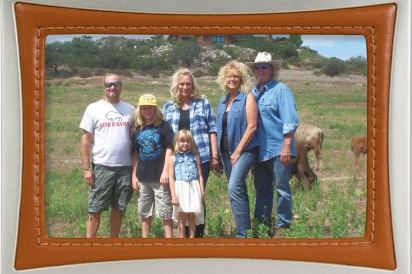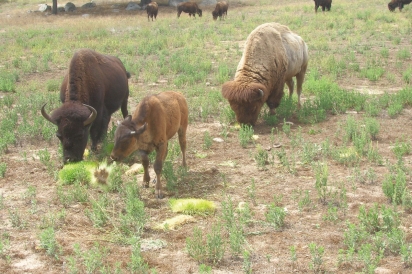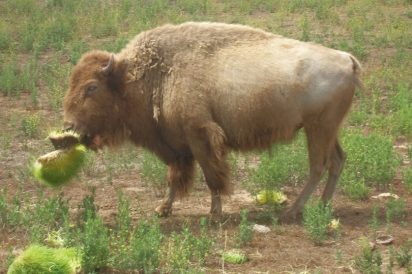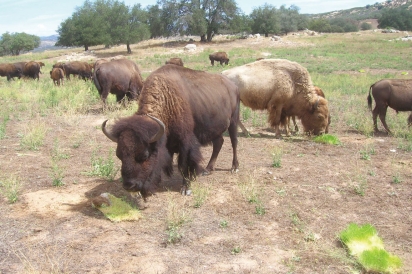The Buffalo Demand
If you live in Southern California, it’s easy to conceal some of your secret cravings. But, when it comes to your diet, it might be time to take a deep breath and tell your friends the truth. You like red meat. You like buffalo.
You aren’t alone. Demand for buffalo (American bison) is outpacing supply. Buffalo’s nutritional profile, not nostalgia, is driving the trend. Health conscious consumers are eating less meat. When they do eat red meat, they look for lean, grass-fed beef or better yet, grass-fed buffalo.
Nationally, the price for prime cuts of buffalo jumped 17 percent in August 2015, according to U.S. Government data. You pay a little less than $6 per pound for quality ground beef. Ground buffalo sells for $9.50 to $14 per pound. Prime buffalo cuts such as rib-eye steak sell for as much as $37 per pound. Despite higher prices, specialty grocers in the United States are selling more buffalo than ever. Their sales are driven by United States Department of Agriculture studies which show that grass-fed buffalo is better for you than beef, pork, chicken and some types of fish.
Orange County residents are buying buffalo burgers at Fuddruckers. They buy buffalo to cook in their own kitchens at The Butchery in Costa Mesa and Whole Foods at the District in Tustin. Their growing appetite for buffalo meat as a healthy source of protein and other vital nutrients drives the market, according to data compiled by Great Range Brand Bison, a Henderson Coloradobased company.
Nutritional studies conducted at North Dakota State University show that bison meat is nutrient-dense. It has a healthy balance of protein, fat, mineral and fatty acids. Strictly by the numbers, buffalo meat is similar to halibut in its nutritional profile as demonstrated in the following table.
Ranchers and chefs claim buffalo is lean and shrinks less than beef when cooked. So, a pound of uncooked buffalo has a higher cooked weight - 20 to 30 percent more - than a pound of uncooked beef, according to the United States Department of Agriculture.
Ramona California resident Ken Childs, founder of the Western Bison Association, has been raising and marketing buffalo since 1980. He and his family have 30 buffalo on their 1,200-acre Star B Ranch in eastern San Diego County. Childs, his wife Denice, their daughter, son-in-law and their grandchildren, tend to the land that supports the buffalo.
“The market for buffalo meat will keep growing faster than ranchers’ ability to produce it,” predicts Childs. “Though it takes about the same amount of land to graze a buffalo cow or an angus or Hereford cow, there are some major differences that drive up the cost of producing buffalo.”
“Fences have to be built higher and stronger for buffalo than cattle. I have seen adult males jump a five-foot fence panel without a running start,” Childs says. “You can’t crowd buffalo into trailers as densely as cattle. The squeeze chutes that you use to immobilize them while you give them shots have to be stronger than the ones you use for cattle.”
And buffalo are more athletic than cattle.
“I‘ve been chased by buffalo. When you see them shake their heads and start swishing their tails and paw the ground, that means they are getting ready to charge you,” Childs says. He was shooting video recently of two adult males challenging each other at what he thought was a safe distance. “All of the sudden, they started running sideways toward me. They didn’t see me and they weren’t trying to harm me. But if I hadn’t gotten out of the way, they would have trampled me,” Childs explains as he reviews the video that gets shaky as he rushed to open the truck door and jump to safety in the cab.
Childs and his wife Denice came to the Star B in 1979. It was owned by Denice’s father, Bert Boeckmann. He is the president of San Fernando Valley-based Galpin Ford, which has been the largest Ford dealership in the country for 25 consecutive years. The same skill that helped Boeckmann build a successful car dealership played a key role in bringing buffalo to California consumers.
“I didn’t know anything about ranching at that time. Denice and I came down here with Bert. He was boarding about 120 horses on the property at the time. He decided he wanted to put the land to better use and started researching the market for buffalo.
“We went to a big buffalo round up in South Dakota (in 1980) and started buying stock for The Star B. We bought seven pregnant cows and a bull to start our herd. As we learned more about buffalo and expanded the herd, we became active in the The Western Bison Association,” Childs said.
The Star B Ranch was one of the first to sell USDA-inspected buffalo meat to a Von’s Pavillion. Soon, he was selling buffalo meat to 33 of their stores. Childs constantly had to travel to states where they raised more buffalo than were available in California. The growth took him further away from his ranch and family.
“It got to be too much work, too many headaches and not enough fun. We sold out to our biggest competitor, Rocky Mountain Natural Meats in 2002. Now, we just raise between 30 and 40 animals,” Childs said.
Star B Ranch also is becoming an ecotourism destination. They drive visitors through their ranch so they can see buffalo grazing in a natural environment. Ted Turner, who owns more buffalo than anyone else in the United States, conducts tours at some of his ranches as well.
Additionally, The Star B Ranch is a case study of a ranch coping with the California drought. Childs had to cut his buffalo herd from 49 to 30 during the last four years.
Statewide, The National Cattlemen’s Beef Association reported 50,000 fewer head of beef were produced in California in 2014 than in 2013. Therefore, wholesalers and grocers must bring in beef from the Great Plains and Midwest. The increased transportation costs drive up the price of beef and buffalo.
Even if it rains and snows more than normal this winter, it will take farmers and ranchers years to bring back the range and replant their fields. The drought has caused California farmers to idle 400,000 to 450,000 acres, about 5 percent of California’s farmland, for the past two years. That’s an area equal to 75 percent of the land in Orange County.
Increased demand for buffalo has helped bring it back from the brink of extinction. In the early 19th Century, millions of buffalo inhabited much of North America. But, as a major ploy in driving Native American tribes off their ancestral lands, European settlers killed all but about 2,000 head of the great buffalo herds. Millions were killed for their hides. Thanks to conservation efforts, the North American Bison population has rebounded from a few thousand in the late 1800s to more than 500,000 today. About 35,000 to 40,000 bison are harvested each year in the United States, according to industry research.
Orange County and Southern California played important roles in bringing back the buffalo. In 1924, 150 buffalo were ferried over to Catalina Island, due west of coastal Orange County. They were needed to make the grassy hills look like the great plains for the silent film version of Zane Grey‘s The Vanishing American. The animals were turned loose when the film crews left the island. Over the years, the heard grew to 600 and started devastating the range. The Catalina Island Conservancy, which manages the herd, ferried half the buffalo off the island. Some went to the Morongo Band of Mission Indians, the Tongva (thought to be Catalina’s original inhabitants some 7,000 years ago). The rest were shipped to the Lakota tribe on the Rosebud Reservation in South Dakota.
Across the channel from Catalina Island in Newport Beach, Bison Street runs between MacArthur and Jamboree just east of Fashion Island. In 1954, a contractor from Kansas built a western-themed amusement park 115 acres he leased from the Irvine Family.
He brought in 100 buffalo. Visitors rode a narrow gage railroad around the acreage and watched the buffalo graze. It was called The Newport Harbor Buffalo Ranch. They served buffalo burgers and staged old west re-enactments. . They sold Buffalo burgers for 55 cents. That’s expensive when you consider that many of the fast food restaurants sold their basic burgers for about 19 cents at the time. By the end of the 1950’s, the Irvine Company had plans to develop the property and the buffalo ranch closed. All that’s left of it today is a road called Bison.
About 150 buffalo live on Camp Pendleton, at Orange County’s southern border. The herd was started in the 1970s with animals donated by the San Diego Zoological Society. Commanders of additional U.S. Military bases are evaluating the feasibility of grazing buffalo to make better use of their land.
Food writers and scholars play an important role in promoting grass-fed buffalo. During an address at the Spring 2015 Natural Food Expo West in Anaheim, food writer Mark Bitman urged attendees to “Eat more plants each day than yesterday and eat more plants next week than last. And when you do eat meat, make sure it comes from animals that are raised without the use or growth hormones, antibiotics or grains,” Bitman said. A trend in that direction would put the population of California and the world in better cumulative health, he added.
E.W. Askew, Ph.D. Professor, Division of Nutrition, College of Health, Health Sciences, University of Utah, Salt Lake City, agrees with Bitman. Askew’s studies show that when humans consumed just under a pound of cooked grass-fed bison meat, their arteries dilated. This caused their blood pressure to drop. When the same group consumed the same amount of grain-fattened beef, their arteries constricted and their blood pressure went up, according to Askew.
Those who are serious about their health and fitness listen to Askew. He includes buffalo and other lean red meats in the diet he recommended to professional and Olympic athletes. Until buffalo becomes available at more stores, Askew suggests eating grass-fed beef rather than grain-fattened beef.
Ted Turner raises more buffalo than anyone else in the United States. Ted Turner bought his first buffalo in 1976. Today, Turner Enterprises, Inc. has two million acres of personal and ranch land in 15 U.S. States and three in Argentina. Some 51,000 buffalo graze on those lands. All of the Turner ranches are managed for one or more of the following: bison ranching, commercial hunting or fishing and limited sustainable timber harvesting. It’s part of a trend toward using more of The West’s public and private land to graze buffalo instead of cattle.
The buffalo herds owned by Turner are handled as little as possible. They graze on grass most of their lives. The code of ethics of the National Bison Association bans the use of growth hormones in bison production. Bison industry protocols prohibit the use of sub-therapeutic antibiotics and animal byproducts in feeding the bison.
On a smaller, more local basis, Mark Nelson, runs 50 head of buffalo at his Bison Rock Ranch in Siskiyou County California, at the foot of the eastern slopes of Mt. Shasta. He says the market for buffalo is growing in Northern California. He tends to his herd on the weekends and during times when he isn’t running his Bay Area construction company.
His fascination with buffalo and early knowledge of buffalo’s nutritional benefits drew him into the business.
“I learned about the American Bison from Doc Jarvie, a friend I made while attending Cal State Davis. He would take me out to observe them grazing and explained they are not at all like domestic cattle. He stressed handling them with caution. He would share experiences and knowledge and start to walk me through various procedures of handling them. Every once in a while, if I wasn’t paying attention, he would shout at me, ‘And then they kill you!”
Once he purchased the ranch, Nelson bought eight mature animals each from a ranch in New Mexico, One in Wyoming and one in Colorado. “I wanted to keep the genetic pool diversified,” Nelson says
From the time they are born, it takes 30 months for a bison to mature. “You get 390 to 590 pounds of meat from a mature bison. “In addition to the grass they graze on, we only feed our buffalo alfalfa hay. We don‘t feed them grain, hormones or any other additives,” Nelson says. He stresses that the nutritional profile of bison or any other type of venison, as with beef, depends largely on the animal’s diet.
Will American Bison ranching become the next big thing in agribusiness? Consumer behaviors show that it may already be on its way. For now, buffalo is still more expensive than beef and prices are rising. Nevertheless, consumers see buffalo as a healthier choice for meat. Sales remain strong and will continue to grow as more consumers learn about its benefits to their health and sustainable agriculture in California and The West.
If you are interested in trying buffalo, check with the following restaurants and markets in Southern California.
RESTAURANTS
Fuddruckers – Lake Forest
23621 El Toro Rd, Lake Forest, CA 92630
(949) 830-7210
Fuddruckers – Buena Park
7802 Orangethorpe Ave, Buena Park, CA 90621
(714) 739-8801
Saddle Peak Lodge – Calabasas
419 Cold Canyon Rd, Calabasas, CA 91302
(818) 222-3888
Josie - Santa Monica
2424 Pico Blvd, Santa Monica, CA 90405
(310) 581-9888
STORES
Whole Foods The District, Tustin
2847 Park Ave, Tustin, CA 92782
(714) 566-7650
Butchery - Costa Mesa
103 E 17th St, Costa Mesa, CA 92626
(949) 548-6328
Iowa Meat Farms - San Diego
6041 Mission Gorge Rd, San Diego, CA 92120
(619) 281-5766









